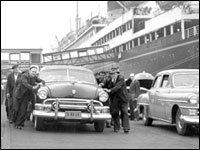The Cunard building was the centre of Britain’s cruise ship industry for many years, a land based reflection of the glory and wealth of cruise liners. Constructed between 1914 and 1918 its design is influenced by grand Italian palaces and reflects the Greek neo-classical revival. Owned by American Samuel Cunard, who sent the first mail boats across the Atlantic, the building has American Eagles looking down on each corner. Cunard later merged with White Star owners of the Titanic, some of the company’s famous ships included the Mauretania, Queen Elizabeth and Queen Mary.
 | | Ships at the Pier Head |
Cruise liners were once a common sight on the River Mersey, millions of people passed through Liverpool on their way to or from North America. Passengers included immigrants sailing to a new life, tourists and celebrities, before the advent of air travel the only way to cross the 3,140 miles of ocean to New York was by liner. Passengers travelling with Cunard would arrive at the Cunard Building to deposit luggage, change money and make last minute arrangements. The basement of the building housed the luggage to be stowed in the hold, within the building there is an ornate corridor with black and white marble floor linking Brunswick Street and Water Street. The first class passenger waiting room is on the river side of the building and has all the luxury and fittings that would provide a foretaste of the elegance of life aboard ship. The glamour of liners
 | | The main route to the Town Hall |
Cruise Liners were like a small town with a large staff and a long list of requirements, Cunard Liners mainly used Huskisson Dock until the 1960’s. Prior to 1919 North Atlantic liners used coal to fuel their engines, the Olympic was the first ship to switch to oil. Loading of coal onto the great liner Mauretania needed 500 railway wagons, took 24 hours and was a messy business, all of the ships furniture had to be covered with sheets, stewards and cleaners then had a day to scrub paintwork clean. The liners provided employment for armies of people in Liverpool, each time one arrived as the last passengers left down the gang plank heading the other way was a procession of painters, cleaners, plumbers and a variety of other tradespeople who would go onboard to prepare the ship for her next voyage. Liverpool laundries would provide the thousands of clean sheets, towels and napkins needed for a voyage, in the 1900’s there were approximately 300 laundries in the city. When a liner arrived for an overhaul it would take four weeks and employ 2000 people to clean and paint every last nook and cranny of the ship. Three Graces
 | | Cars are loaded on to ships |
To your left is the Royal Liver Building, the head offices of the Royal Liver Friendly Society. Built on bales of cotton the foundations are in a former dock, George’s dock which was once full of sailing ships. The building’s clock faces beneath the famous Liver Birds are the largest in the country, two and a half feet bigger than Big Ben, They are called George clocks as they were started at the exact moment that George V was crowned on 22nd June 1911. The Liver Birds are the largest in the city at 18ft high with a spread of wings at 12 feet. The third of the three great buildings at the Pier Head is the Port of Liverpool building built for Mersey Docks and Harbour Company. On either side of the door of this building you can see a steam ship and a sailing ship representing the ocean. There is also a figure of King Neptune riding on waves and dolphins holding globes. This building is where all Liverpool ships had to register. | 


